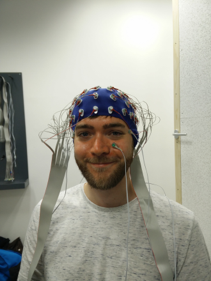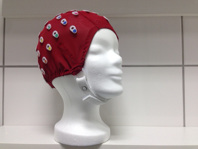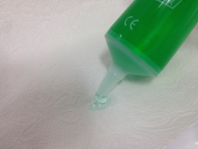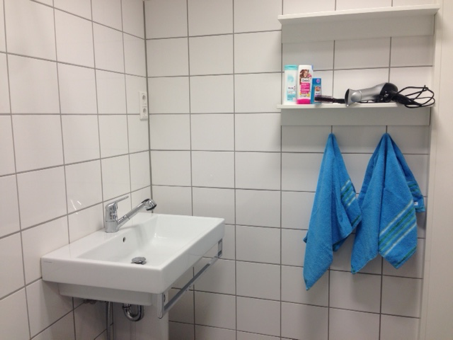Frequently asked questions
- 1. What will be measured?
- 2. How does the measurement work?
- 3. Does EEG hurt?
- 4. Who can participate?
- 5. What about retainers / piercings and tattoos?
- 6. How long does all the preparation take?
- 7. How does a lab look like?
- 8. What kind of technical equipment is used?
- 9. Where is the lab?
- 10. Removing the gel after the measurement…
- 11. Does the measurement influence me? Is it risky?
- 12. What does the EEG want to explain?
- 13. What should I pay attention to?
- 14. Do I learn anything about my own brain activity?
- 15. What does the instructor come to know about me? Is the EEG able to scan my thoughts?
- 16. What happens with my data?
What will be measured?
EEG is used to measure electrical signals sent when neurons in our brain are activated. More precisely, an EEG shows postsynaptical potencials of cortical “pyramid cells“. Therefore it is very useful to monitor all activities appearing in human brain as soon as a person starts to think, experience or notice something.

How does the measurement work?
Electrical current in human brain is measured by little electrodes, which are connected with an intensifier by wire. Small electrodes will be spread across the whole scalp in order to detect the brain area, where the electrical current comes from. The electrodes are placed in a cap which is worn during the measurement. This guarantees that the electrodes‘ position remains correctly and consistent over all participants. The mandatory electroconductive connection to the scalp is achieved by using a conductive gel. It mostly consists of water, common table salt and a thickening matter. The gel is hypoallergen and can be washed out easily after the measurement. Our EEG-system achieves a good signal quality without rasping over the scalp.


Does EEG hurt?
No! Neither the preparation nor the measurement itself causes any pain. Indeed, some EEG-systems are known to create unpleasant feelings by rasping the gel over the scalp. However, our system is different. We do not need to rasp the gel over your scalp so you won`t have any pain or unpleasant feeling. The measurement itself is passive, which means that no external electricity is applied. We just measure that kind of electrical current your brain produces either way.
Who can participate?
Generally everybody is able to take part in our studies. Your participation is independent from sex or handedness. Certainly it is absolutely important that your eyes work faultless. If you have any trouble with visual impairment, you should bring your glasses or contact lenses.
Moreover, there are some general criteria for exclusion:
- Neurological disease, mental disorders and the intake of tablets against mental and neurological disorders
- Big pigtails and dreadlocks
What about retainers / piercings and tattoos?
None of it causes any problem. There is neither a risk for the participant nor for the measurement. Mostly you can even keep your jewelry.
How long does all the preparation take?
Normally the preparation for such a measurement takes about 20 minutes. The exact term depends on the number of electrodes which has to be used. The preparation time is considered when it comes up to “participant hours“ or to financial expenses.
How does a lab look like?
Our lab is a small chamber, so the participant is able to work unhindered without any disruption, e.g. by noises or comments of the investigator.
What kind of technical equipment is used?
Our lab features ultra-modern measurement devices.
Eyetracking:
- Tobii Pro Glasses 2 (mobile eyetracker)
- SR-Research EyeLink 1000 Plus (high-resolution stationary eye-tracker)
EEG:
- Biosemi ActiveTwo active electrode 128-channel EEG system
- BrainProducts LiveAmp mobile EEG system
Monitors and programmes:
- Zero-latency VIEWPixx / EEG LCD Monitor
- High-Performance Matlab/Python/R for data analysis
Moreover, the lab is temperature-controlled to make the measure as comfortable as possible.
Where is the lab?
You can find our lab in the department of psychology, Fliednerstraße 21, room FL. 161b on the first floor.
Removing the gel after the measurement…
Washing-off the gel is a simple business, because our gel is water-soluble. Our laboratory has a sink, moreover shampoo, a hair-dryer and towels are at your disposal so that you can wash your hair after the measurement. You may also bring along your own shampoo and conditioner if you prefer to.

Does the measurement influence me? Is it risky?
EEG measurement is passive. We observe the electrical current of your brain but do not influence it in any way. We also do not generate any additional artificial electrical current or magnetic fields. That means our measurement is absolutely riskless.
What does the EEG want to explain?
As Psychologists we seek to understand the mind. Therefore, the observation of behavior (like response time or error ratio) can be very useful and informative. Beyond that we are especially interested in phenomena that are not directly shown by behavior.
For example, we can use memory tasks to check, whether participants are able to remember a certain word learned before by measuring the button they press. But what kind of process occurs in the minutes before? What happens in our brain and causes that words are either remembered or forgotten? And what leads us to push the right button? To answer such questions we need electrical current and neuronal signals measured by the EEG to explain mental processes we cannot observe by behavior.
Moreover, these neuronal signals can also act as an indicator for electrical excitability.
What should I pay attention to?
There is nothing special you have to pay attention to before the measurement starts. Indeed you should go to the toilet before, because this is hardly possible as soon as you wear the cab with all its electrodes and wires. The experiments should not be interrupted.
Although there is no risk at all, we suggest to wash out the gel after the measurement. As already mentioned, you can find all required equipment in our lab.
Do I learn anything about my own brain activity?
Each EEG based experiment has been planned to answer a certain research question. Like any other neurophysiological measurement the EEG can only provide information tested in the running experiment. In a memory experiment for example, we can measure how precise a participant’s neuronal signals distinguish between already learned and new words. However, data from this experiment can never provide a basis to explain phenomena like intelligence or creativity. Especially in neurology, EEG measurement is used to detect neurological interference like epilepsy. In studies like that the research question is a different one so that the EEG conditions need to be changed. Thus our EEG measurement is not suitable for diagnostics.
If you are interested in what your EEG data signify concerning the experiment you took part in, please contact the instructor. Accordingly, we are able to show you an illustration of your brain activity and the experimental effects found in this study.
What does the instructor come to know about me? Is the EEG able to scan my thoughts?
All information we get from the measurement is confined to a certain research question (like in a memory experiment: “Does the EEG signal distinguish between remembered and forgotten words?“) Moreover, we can hardly say anything about your thoughts, personality or emotional being. On top of that it is nearly impossible to find out anything about your mental state in a certain moment, because the EEG signal is not reliable and needs to be averaged over several trials.
Our studies collect data from a great number of participants so that results and statistical analysis refer to the whole sample. The consideration of individual participants` results is just an intermediate step.
What happens with my data?
We collect data from the EEG, your behavior (response time, error ratio) and some demographic data like your age and sex. It is of great importance for us that storage and handling of your data is safe. As we are obliged to keep privacy protection, we make your data anonymous as soon as the experiment is finished. Instead of saving your name, we label your data with a number like “VP129087“. To combine this number to your data and your name a special list is required. This list is not stored digitally and exclusively the instructor has access to it. Once the study is finished and results are published, we will delete this list so that nobody is able to combine any participants’ numbers with names. Guidelines of the German Research Community request the storage of anonymous data for at least ten years after the study has been finished.
